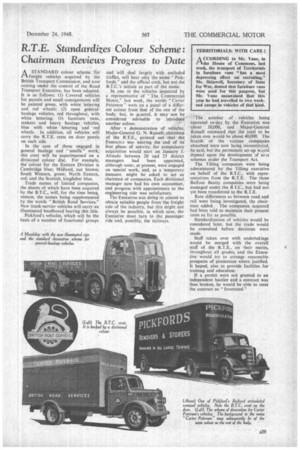R.T.E. Standardizes Colour Scheme: Chairman Reviews Progress to Date
Page 31

If you've noticed an error in this article please click here to report it so we can fix it.
ASTANDARD colour scheme for freight vehicles acquired by the British Transport Commission, and now coming under the control of the Road Transport Executive, has been adopted. It is as follows: (1) Covered vehicles for parcels and small consignments will be painted green, with white lettering and red wheels; (2) open generalhaulage vehicles, Ted throughout,' with white lettering; (3) furniture vans, tankers and heavy haulage. Vehicles, blue with white lettering and red wheels. In addition, all vehicles will carry the R.T.E. crest on door panels on each side.
In the case of those engaged in general haulage and "smalls" work, this crest will be superimposed on a divisional colour disc. For example, the colour for the Eastern Division is Cambridge blue; Midland, nut brown; South Western, green; North Eastern, red; and the Scottish, kingfisher blue.
Trade names of limited companies, the shares of which have been acquired by the B.T.C., will; for the time being, remain, the names being supplemented by the words "British Road Services." New trunk-service vehicles will carry an illuminated headboard bearing this title.
Pickford's vehicles, which will be the basis of a number of functional groups and will deal largely with excluded traffics, will bear only the name " Pickfords" and the official crest, but not the
initials as part of the name. . In one of the vehicles inspected by a representative of "'The. Commercial Motor," last week, the words -"Carter Paterson ". were on a panel of a different Colour from that of the•rest or the body,but, in general, it may not be considered advisable to introduce another colour.
After a demonstration of vehicles, Major-General G. N. Russell, chairman of the R,T.E., pointed out that the Executive was nearing the end of its first phase of activity,, for doinpulsory acquisition would start on January 1. Already between 20 mad 25 district managers had been appointed, although some, at present, were engaged on special work, and, as a temporary measure, might be .asked to act as chairmen ot companies. Each divisional manager now had his own accountant, and progress with appointments to the engineering side was satisfactory.
The Executive was doing its utmost to obtain suitable people from the freight side of the industry, but this Might not always be possible, in which case, the Executive must turn to the passenger side and, possibly, the railways.
-The _ number of vehicles being operated to-day. by the Executive was about .I0,000, and Major-General Russell estimated that the total to be taken ovet would be about 40,000. The boards of the various companies absorbed were now being reconstituted, he said, but the permanent set-up would depenJ upon the development of arm schemes under the Transport Act.
TheTilling 'companies were being administered by the lilting executive on behalf of the B.T.C., with representatives from the R.T.E. The three Balfour Beatty companies were being managed under the B f.C., but had not yet been transferred to the R.T.E.
Rate differences as between road and rail were being investigated, the chairman added. The companies acquired had been told to maintain their present rates as far as possible.
Standardization of vehicles would be considered later, but the trade would be consulted before decisions were made.
Staff taken over with undertakings would be merged with the overall staff of the R.T.E., on their merits, throughout all grades, and the Executive would try to arrange reasonable prospects of promotion where justified. It hoped, also to provide facilities for training and education.
If a permit were not granted to an independent haulier and a contract was thus broken, he would be able to treat the contract as "frustrated."




















































































